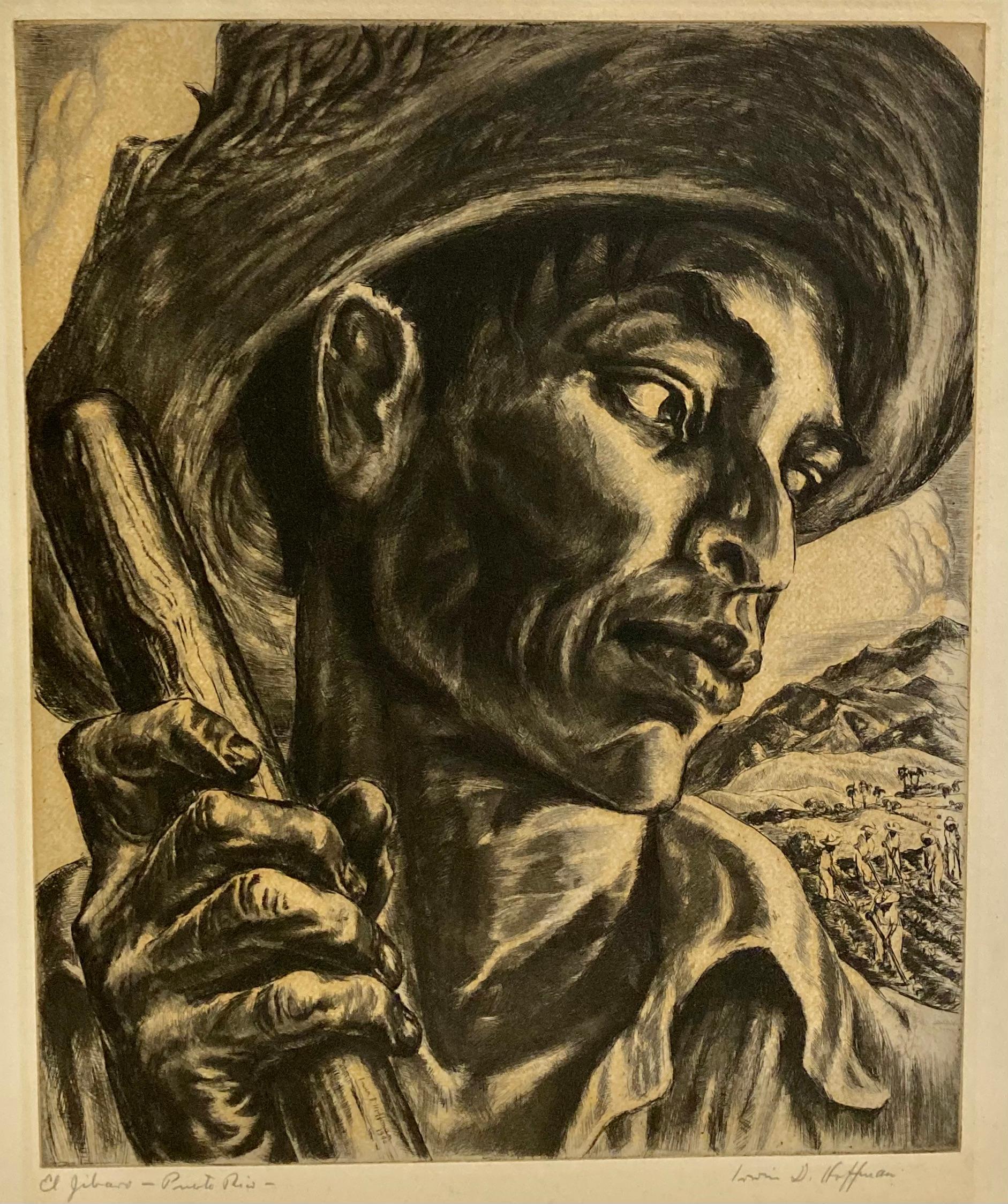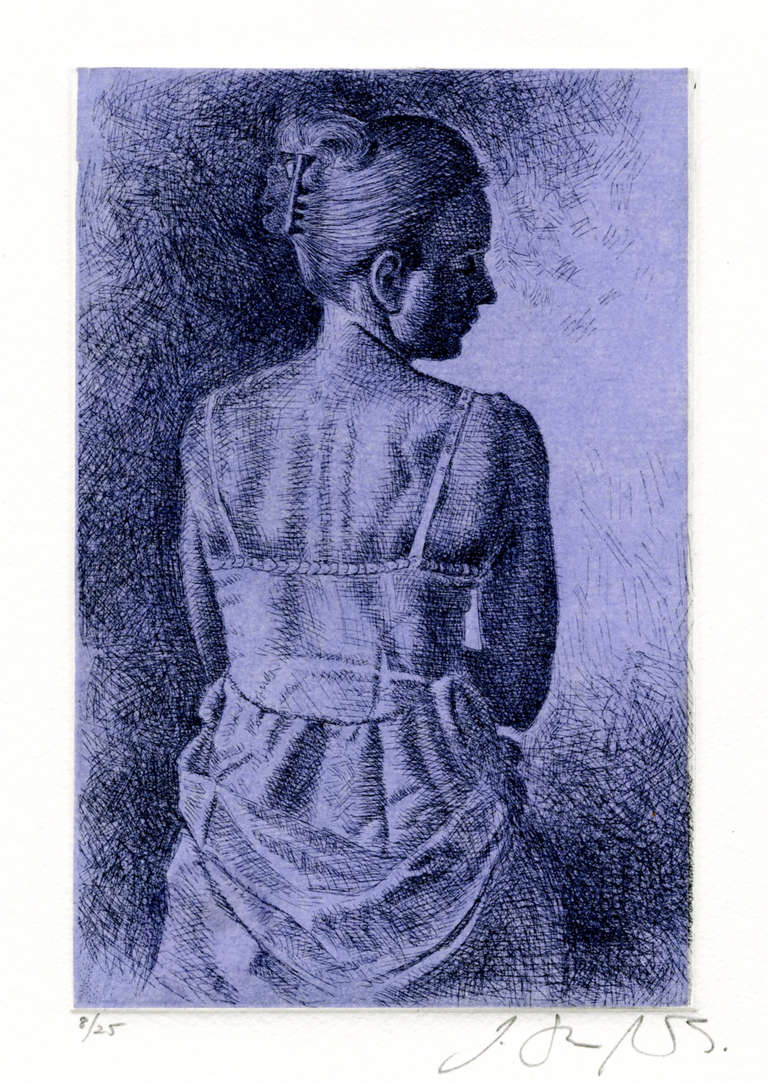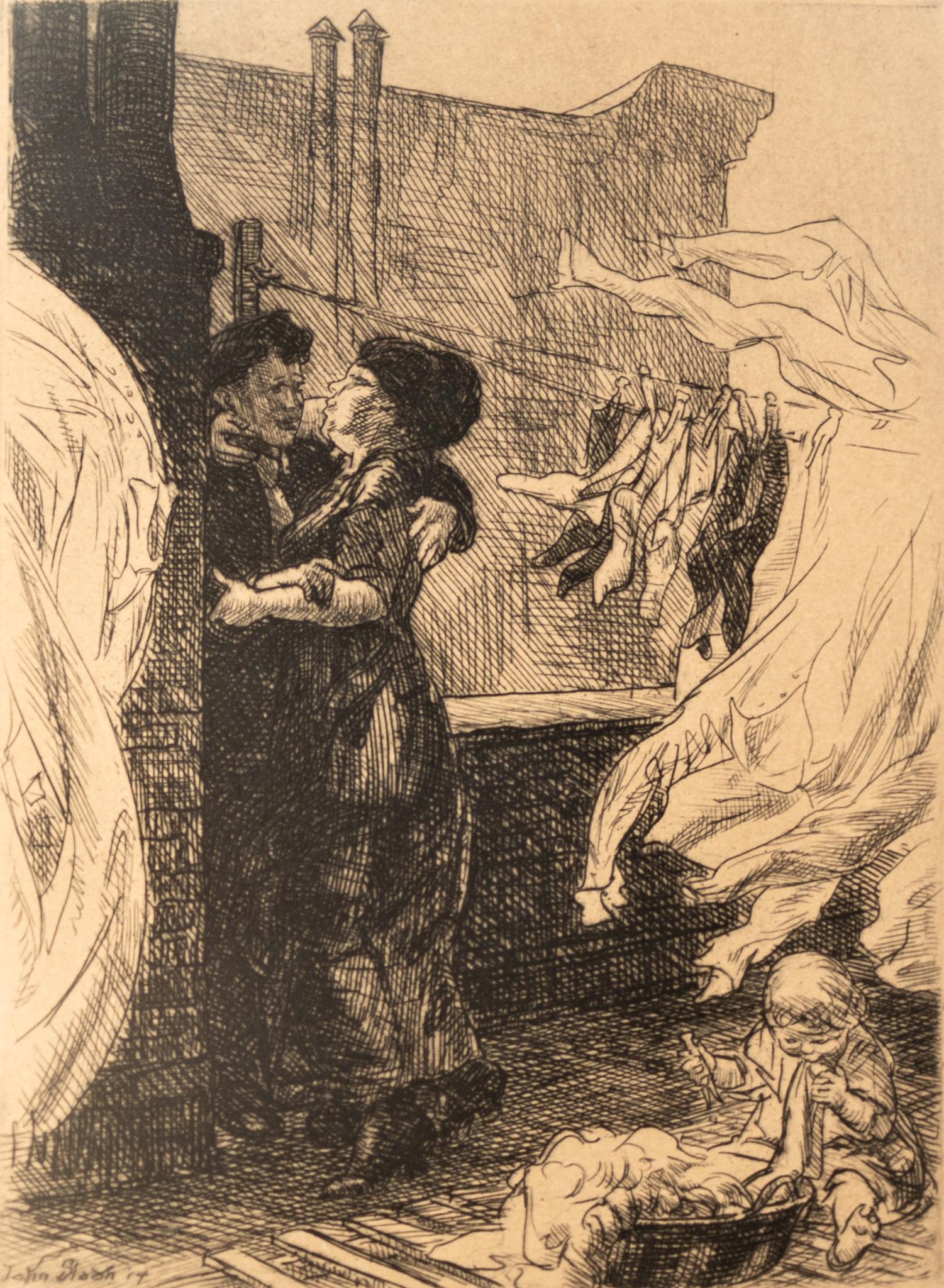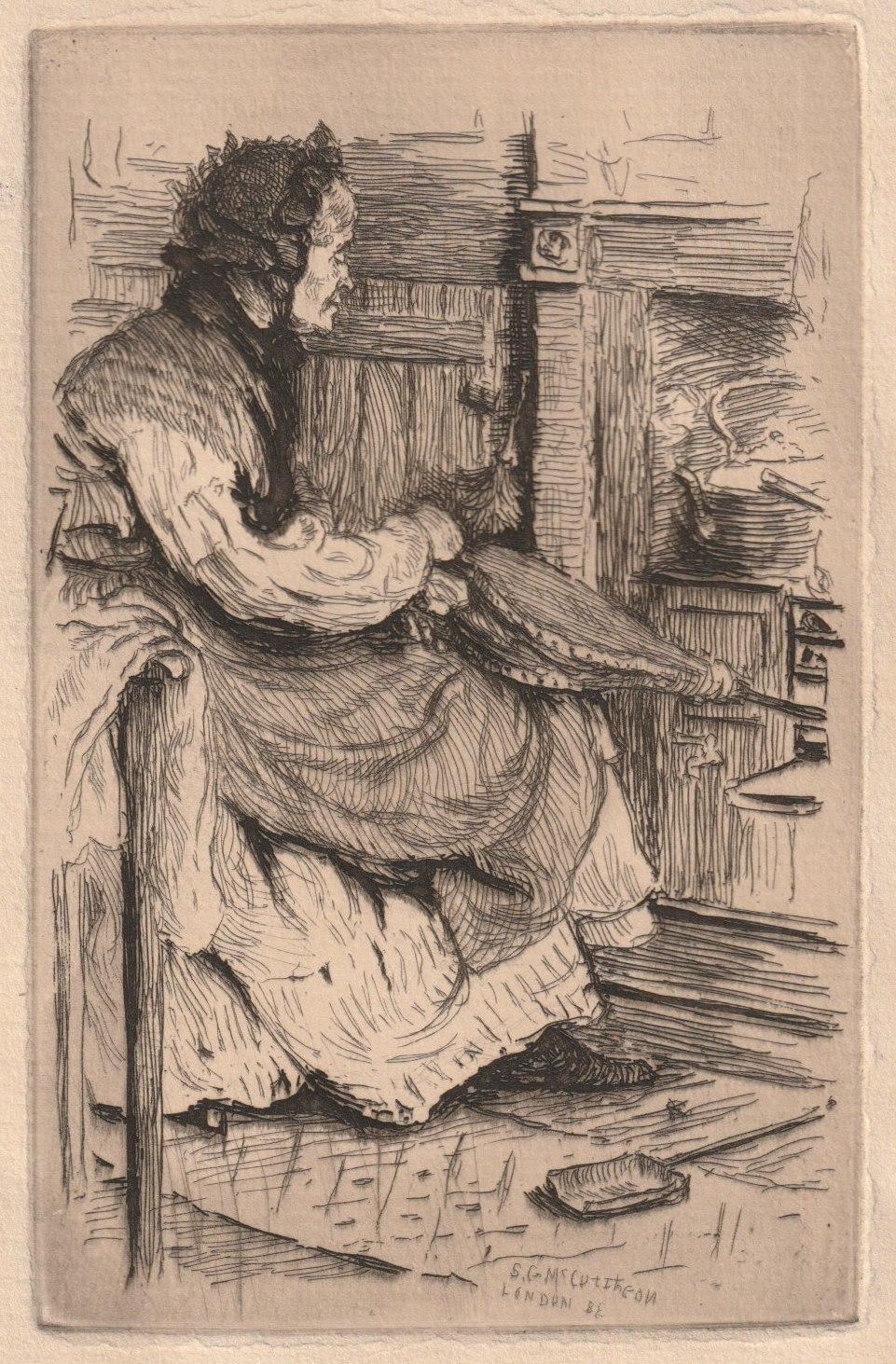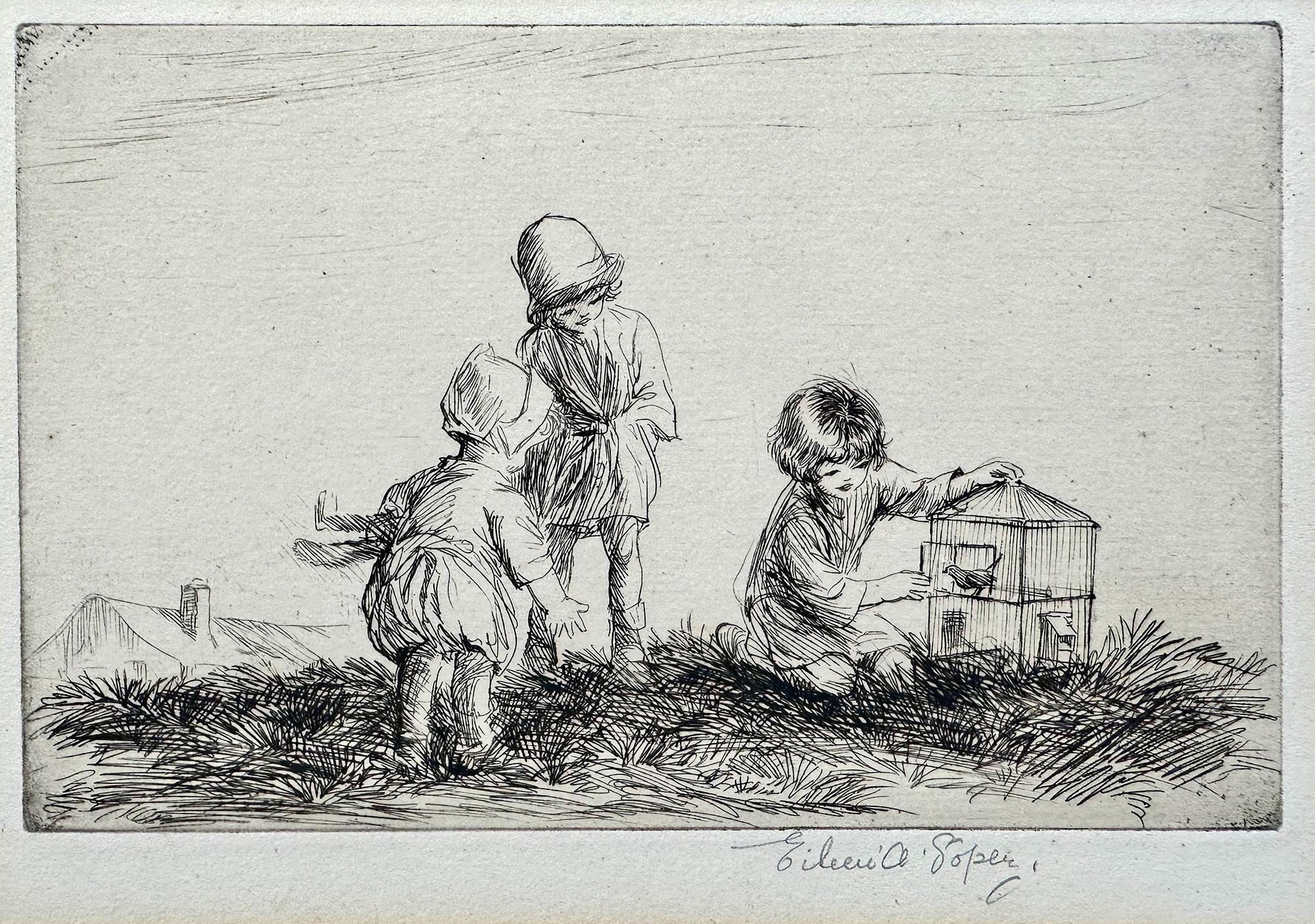Items Similar to Sunday Morning
Want more images or videos?
Request additional images or videos from the seller
1 of 8
Dox ThrashSunday Morningca. 1939
ca. 1939
About the Item
Sunday Morning. Title: Sunday Morning
Artist: Dox Thrash (American, Griffin, Georgia 1893–1965 Philadelphia, Pennsylvania)
Printer: Sam J. Brown (1901-1994).
Date: ca. 1939.
Medium: Drypoint
Dimensions: sheet: 12 5/8 x 10 5/8 in. (32 x 27 cm)
plate: 8 7/8 x 7 7/8 in. (22.5 x 20 cm)
This is the most heavily inked, atmospheric example known to exist. Unique, unsigned example from the collection of artist Samuel J. Brown.
Dox Thrash (1893–1965) was an African-American artist who was famed as a skilled draftsman, master printmaker, and painter and as the co-inventor of the Carborundum printmaking process.[1] The subject of his artwork was African American life. He served as a printmaker with the W.P.A. at the Fine Print Workshop of Philadelphia. The artist spent much of his career living and working in Philadelphia, Pennsylvania.[1]
Early life
Dox Thrash was born on March 22, 1893, in Griffin, Georgia.[2] He was the second of four children in his family. Thrash left home at the age of fifteen in search of work up north. He was part of the Great Migration (African American) looking for industrial work in the North.
The first job that Thrash got was working with a circus and a Vaudeville act. In 1911, at the age of 18, he moved to Chicago, Illinois.[3] He got a job as an elevator operator during the day, and used this source of income to attend school.[3] In 1914 he attended the School of the Art Institute of Chicago.[1]
In 1917, the United States declared war on Germany and entered World War I. In September 1917, at the age of twenty-four, Thrash enlisted in the army.[3] He was placed in the 365th Infantry Regiment, 183rd Brigade, 92nd Division, also known as the Buffalo Soldiers.[1] During combat, Thrash suffered shell shock and a gas attack, but was not permanently injured.
Career as an artist
Front cover of Dox Thrash: An African American Master Printmaker Rediscovered, by John Ittmann.
After having served in the war, Thrash qualified as a war veteran and enrolled in the Art Institute of Chicago with the support of federal funding.[3] After finishing his education, he traveled intermittently from Georgia to Chicago, Boston, New York, and finally Philadelphia, working odd jobs - experiences that provided him with subject matter to later paint. Settling in Philadelphia by 1925, he took a job working as a janitor. In his free time, he continued his art career and used his talent to create emblems, such as the one for the North Philadelphia Businessmen's Association, and posters in exhibitions and festivals, including the 2nd Annual National Negro Music Festival and the Tra Club of Philadelphia.[1] This gained him local recognition and opened doors for new artistic endeavors. By 1929, Thrash was attending nightly classes within these clubs, namely with Earl Horter of the Graphic Sketch Club, now known as the Samuel S. Fleisher Art Memorial.[3]
In 1937 Thrash joined the government-sponsored Works Progress Administration (WPA)'s Federal Art Project.[4] Through the WPA, Thrash began working at the Fine Print Workshop of Philadelphia.[5] At the Fine Print Workshop of Philadelphia, Thrash, along with Michael J. Gallagher and Hugh Mesibov, began experimenting and co-inventing the process of carborundum mezzotint, a printmaking technique.[1] Carborundum printmaking uses a carbon-based abrasive to burnish copper plates creating an image that can produce a print in tones ranging from pale gray to deep black. The method is similar to the more difficult and complicated mezzotint process developed in the 17th century. He used this as his primary medium for much of his career and created his greatest works with it. One of his first pieces employing this nascent technique was his anonymous self-portrait entitled Mr. X.
With this new technique, the three gained increasing recognition as they published more and more graphics within newspapers and featured more and more pieces within exhibitions. Their works often featured subtle commentaries about social and economic exploitation regarding the contemporary politics of the Great Depression and the Second World War. By 1940, Thrash, Gallagher, and Mesibov all began to gain attention in local circles for their carborundum prints, although the role that each artist played in the development of the process was left unclear.[6]
In 1960, Thrash participated in a show at the Pyramid Club, a social organization of Black professional men that held an annual art exhibit starting in 1941. Others on hand were Howard N. Watson, Benjamin Britt, Robert Jefferson and Samuel J. Brown Jr.
Thrash spent the later years of his life mentoring young African American artists. He died on April 19, 1965, in Philadelphia, Pennsylvania.[2] He was posthumously honored almost 40 years later in 2001 with a major retrospective, titled Dox Thrash: An African-American Master Printmaker Rediscovered, at the Philadelphia Museum of Art.[7]
Thrash's work was included in the 2015 exhibition We Speak: Black Artists in Philadelphia, 1920s-1970s at the Woodmere Art Museum.[8]
Relation to Alain Locke and the New Negro Movement
This section needs additional citations for verification. Please help improve this article by adding citations to reliable sources in this section. Unsourced material may be challenged and removed. (June 2022) (Learn how and when to remove this template message)
Alain LeRoy Locke (1885-1954) was an intellectual, professor and author who espoused that African Americans, specifically artists, to capture the personality, lives, and essence of their people in The New Negro. He explained “The Negro physiognomy must be freshly and objectively conceived on its own patterns if it is ever to be seriously and importantly interpreted. Art must discover and reveal the beauty which prejudice and caricature have overlaid.”[9] What Locke is expressing here is not only the call for black artists to overcome racial prejudices via positive artistic representations of blacks, but that the actual African American individual like Thrash portrayed the lives of fellow blacks, and had the power to propagate this idea of the New Negro, as Locke explains, “There is the possibility that the sensitive artistic mind of the American Negro, stimulated by a cultural pride and interest, will receive…a profound and galvanizing influence.”[10]
In his shadowy carborundum mezzotint Cabin Days, Thrash depicts a southern black family on the porch of their shack-like home in a rural landscape. The man, woman, and child, clutched tenderly to the female figure's breast, create an intimate scene highlighted by the bright cleanliness of the laundry hanging behind them. Placed in front of the drying laundry, they are framed by one aspect of the hard work accomplished during the day. Close to one another, staring collectively outward at the Southern landscape, they, and their laudable priorities of cleanliness and family, are made the bright focal point in the poor, unstable atmosphere. Such inner warmth is seemingly incompatible with the family's crooked and disheveled surroundings, and their fuzzy appearance with a lack of facial detail makes the scene into a general archetype for rural southern blacks living conditions and qualities. Thrash was referencing an experience common to thousands of black families in rural occupations at the turn of the 20th century, often forced into slavery-like tenant farming as their only means of livelihood in the racist South. The “uneven clapboards, leaning porch, broken shutter, and uprooted fence” are rife with instability, much like the post-slavery economic and social systems of the South, making it clear that for African Americans, “the house is not the home; rather, the figures on the porch represent family unity and continuity”.[10] In this way, Thrash is able to not only champion the positive qualities of blacks in the family setting but underscore this with a symbolic look at their disadvantaged situation, making it all the more impressive that they persevere. Thrash symbolically depicted harsh realities for the African American at this transitional point in history while conferring a sensitive rendering of their humanity, akin to any other race, despite its utter denial by American society.
Through softer tempera washes like A New Day, he literally and figuratively paints a picture of a black family transitioning from the South to the North during the Great Migration, making a hopeful, daring leap to attempt to be equal members of the society that has historically oppressed them. On the left side of the canvas lie muddled farm houses and plow handles, embodiments of their rural life of tedious hard labor behind them, fading to gray. Their hopeful gazes “…convey the optimism of the scores of African Americans who left the countryside to pursue better job opportunities, health care, and education in urban centers”.[6] The stance of the figures, with their chins raised in a dignified gesture towards cityscape ahead suggest a confidence and ambitiousness in their collective futures in this new northern industrial terrain. Even the child, clutched securely in the arm of the mother figure against her breast is not only serenely grinning, but calm enough to appear to gently doze, confident in that the journey ahead will result positively, poses no threat. The exposed arm of the woman is notable as well, being unusually thick and muscular, along with the general proportions of the kneeling father, who position on the ground appears not pleading but rather in a slightly exhausted, but upright gratefulness for the promise ahead. Thrash makes it clear that this family has traveled a long way, but is not depleted; rather they are strong and preparing for further hard work and hopeful success ahead. They are the quintessence of the New Negro, in that they are not only journeying forward to seize previously unobtainable opportunities that will enhance their lives, but the manner with which they hold themselves provokes a certain level of warranted respect for their humanity, from the viewer.
In fact it was the strength of his fellow African Americans that Thrash often emphasized, amongst other positive characteristics in the face of adversity in personal portraits. Through his carborundum print Life, he depicts a neatly dressed black girl reading what appears to be a newspaper or magazine. The subject stares intently at her material, fixated on the abundance of text. Art historian Richard Powell describes it best, stating that Life's “non-racial genre scene, soft sells that Black children, too, experience the thrills and tender moments of youth. These underlying themes of commonalities and unity contribute to an aesthetic of being part of a larger system as opposed to being separate from it.”[10] Thrash's conscious decision to not only give specific attention to a black subject through a portrait, but to place the child as engaging in an intellectual pursuit that crosses racial borders enforces a positive view of African Americans as intelligent, integral members of society akin to whites. The lighting of the print adds to this effect as well. The room in which the girl sits is dark and shadowy, however, the light source shines directly upon her face and lap, emphasizing her beautifully carved young features engrossed in the reading material. In addition, her social status is touched upon by her clean, well-tailored, and fashionable dress of the day. Her literacy is therefore inextricably interwoven with her personal and familial success. She is the antithesis to Locke's idea of the caricature of blacks whose poses and exaggerated features were made to dehumanize and convey a diminished sense of intelligence and capability.
Thrash also acknowledged common cultural clashes and challenges faced by African Americans through his portraiture as well. In his etching Saturday Night, he depicts a female hairdresser readying herself for a night on the town. Her facial features and coloring distinctly label her as African American, and it is the act she is engaging in that is of utmost importance. The woman is straightening her naturally curly hair with a hot iron. She is conforming to physical standards foisted upon her by the dominant white society where straight hair is a marker of beauty. Though muscular, shapely, and attractive, she feels the need to engage in the laborious task of making her tightly coiled hair straight in order to prepare for the night in the public sphere. In fact, weariness at the task is written all over her face, the scratchy lines of the etching giving heavy shadow to the area underneath her eyes and the lines touching from her nostrils till the outsides of her lips. This technique of etching lends a weariness or faded quality to the entire piece, the woman and her world appearing to be worn down to a mere skeleton of their realities. Her left leg casually draped across her right and the ease with which she appears to hold the straightening tool signify the routine quality of this preparation, despite her apparent dissatisfaction at the procedure. Throughout all of this, she directly confronts the viewer with a strong gaze, as if the audience is her mirror. It is as if Thrash was literally reflecting his African American audience back at themselves, hinting at the psychological expense of attempting to conform to pre-existing white norms. Such an activity, though on the surface merely a shallow process of beautification, carries with it the idea of rejecting your natural physical state, or rather one's blackness. To Locke and Thrash, this was not viewed as positive for African Americans considering that it the connotation of such an act of conforming to the aesthetic norms of white society puts the natural condition of blacks in a categorization of less than optimal, or ugly. Such a sentiment does not produce pride for the community or bolster the idea of the New Negro. However, Thrash's acknowledgement of the common practice, reflecting it back to the community, is a step towards progressing towards a more positive, independent state.
Relation to W. E. B. Du Bois
In an editorial in the monthly magazine The Crisis, W. E. B. Du Bois, another father of “The New Negro Movement,” said “let us train ourselves to see beauty in black”.[11] Dubois called upon African-Americans to be proud of their heritage instead of being ashamed of their dark skin. This racial image issue was another characteristic of the African-American experience at this time. Thrash addressed the issue by creating portraits of African-American subjects and ideal heads using his carborundum mezzotint method that defined typically black facial features in a more realistic manner. At a time when white artists illustrated blacks barbarically in cartoons and newspapers, tasteful portrayals of black subjects were highly influential.
In Thrash's illustration of an African-American woman in his print Marylou, the chiaroscuro effect is extreme. Unlike some of his prints, there is minimal, visible white space in this print, except for around the subject's head. Resembling a halo, the light space bordering the woman's head gives the viewer a sense that there is something pure and righteous about her. She is not tainted or inferior as white society might try to imply. This could be Thrash's attempt to see the beauty in black as W. E. B. Du Bois called upon African-Americans to do in his editorial. Although this painting focuses on an individual, the way that the woman's eyes are illustrated makes her seem as though she is not a specific individual. Her extremely darkened eyes prevent the reader from identifying a precise woman, which enables the viewer to accept her as a symbol of the beauty of all African-American women.
- Creator:Dox Thrash (1893 - 1965, American)
- Creation Year:ca. 1939
- Dimensions:Height: 9 in (22.86 cm)Width: 8 in (20.32 cm)
- Medium:
- Movement & Style:
- Period:
- Condition:
- Gallery Location:Wilton Manors, FL
- Reference Number:1stDibs: LU245213488512
About the Seller
4.9
Vetted Seller
These experienced sellers undergo a comprehensive evaluation by our team of in-house experts.
Established in 2007
1stDibs seller since 2015
322 sales on 1stDibs
Typical response time: 5 hours
- ShippingRetrieving quote...Ships From: Wilton Manors, FL
- Return PolicyA return for this item may be initiated within 7 days of delivery.
More From This SellerView All
- Didn't He Ramble? (Jazz Musician Trumpet Player)Located in Wilton Manors, FLWhitford Carter (1915-1973). Didn't He Ramble?, 1964. Lithograph on paper, image measures 13 x 17 inches; 19 x 22 inches in original frame. Signed, dat...Category
Mid-20th Century American Realist Figurative Prints
MaterialsLithograph
- Des Ongles et Du Bec (abstract female portrait)By Georges RouaultLocated in Wilton Manors, FLArtist Georges Rouault (1871, France - 1958, France) Main title "Des ongles et du bec" Etching and aquatint on wove paper. Creation date 1926 / 1948 Publisher: Etoile Filante, P...Category
Mid-20th Century Abstract Abstract Prints
MaterialsEtching, Aquatint
- Portrait of a Young Girl (the artist's daughter).By Joseph FlochLocated in Wilton Manors, FLJoseph Floch (1894-1977). Young Girl, c.1930s. Lithograph on paper, plate measures 9 1/8 x 13 3/4 inches. Measures 17 x 21 inches framed. Excellent condition with no damage or conser...Category
1930s Realist Figurative Prints
MaterialsLithograph
- Undergarment Model (1970s Gay Bathhouse Jockstrap Ad)Located in Wilton Manors, FLVintage jockstrap ad poster, 1975. Offset lithograph on paper measures 18.5 x 12.75 inches. Copyright Winifred Bonney. Original offset period print on perio...Category
1970s Realist Figurative Prints
MaterialsOffset
- MalachBy Jerome KaplanLocated in Wilton Manors, FLJerome Kaplan (1920-1997). Malach (Angel), 1952. Lithograph on wove paper. Image measures 15 x 19 inches; 23 x 28 inches in custom shadowbox frame with custom beveled linen matting. ...Category
Mid-20th Century Abstract Abstract Prints
MaterialsLithograph
- Fillmore Psychedelic music posterLocated in Wilton Manors, FLOriginal Fillmore concert poster. 4-color screen print. Excellent condition. No fading or staining. The 1st poster was printed before the concert and measures 13 5/16" x 21 3/4".Category
1960s Abstract Figurative Prints
MaterialsScreen
You May Also Like
- Coney Island, PP, Ed./50, 1935By Paul CadmusLocated in Washington Depot,, CTA printer's proof of an edition of 50. Depicting Cadmus' sense of humor and style. The beautiful frame dimensions are 18.5 x 19.5".Category
1930s American Realist Figurative Prints
MaterialsPaper, Etching
- Irwin D. Hoffman, El Jibaro -- Puerto RicoBy Irwin D. HoffmanLocated in New York, NYThis subject was published by Associated American Artists in an edition of 162. In the AAA catalogue raisonné of publications, by Gail Windisch, Art for Every Home, it serves as the...Category
1940s American Realist Figurative Prints
MaterialsEtching, Aquatint
- Figure Study (From Interior: Evening)By Stone RobertsLocated in Fairlawn, OHSigned and numbered by the artist Edition: 25 Printed on Hahnemuhle paper Published by Neptune Fine Arts Condition: excellent Plate/Image size: Sheet size: "Stone Roberts’ luminou...Category
20th Century American Realist Figurative Prints
MaterialsEtching
- "Love on the Roof" American Realist EtchingBy John SloanLocated in Austin, TXBy John Sloan American Realist From the early 20th century Ashcan School which focused on capturing day to day life in New York City during that period. Image size: 5.75" x 4.25" Et...Category
Early 20th Century American Realist Figurative Prints
MaterialsArchival Paper, Etching
- My Ain Fireside, from the portfolio Some Modern EtchingsLocated in Middletown, NYEtching on thick, hand made laid paper, 8 1/8 × 5 13/16 inches (206 × 148 mm), full margins. Scattered light age tone surface soiling, dog-eared corners, and minor edge nicks. An imp...Category
Late 19th Century American Realist Portrait Prints
MaterialsHandmade Paper, Laid Paper, Etching
- Children freeing a caged birdBy Eileen SoperLocated in Middletown, NYEtching on cream wove paper, 4 1/2 x 7 inches (114 x 177 mm), wide margins, signed in pencil in the lower right. Laid down to non-archival board with the mat affixed, obscuring the v...Category
Early 20th Century American Realist Figurative Prints
MaterialsHandmade Paper, Etching
Recently Viewed
View AllMore Ways To Browse
Space Clutch
Early Boston Etchings
Vintage Skin Tight Dress
Pyramid Clutch
Shadow Clutch
Atelier September
8 X 10 1908 Painting
Textile Relief Wall Art
Flower Wood Cut Print
Female Head Sculpture Glass
19th Century Painting Of A Steamship American
Italian Clown
Pistol Bird
Shield Pins
Study Print Set Of Four
Man In Blue Picasso
Japanese Song Painting
Il Vecchio

